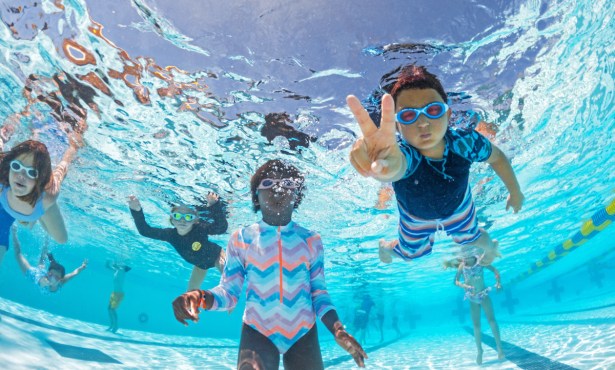Santa Barbara, Surfers, and the Interweb
Logged On and in the Lineup
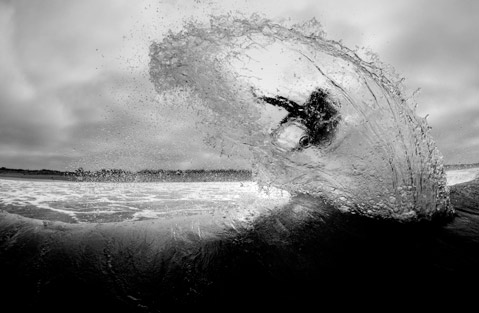
When the first west swell of the season began making its way toward the all-too-sleepy shores of Santa Barbara a few weeks ago, the hype machine was in full effect. Surfers big and small were giddy with anticipation-winter was finally coming and they knew it. For most, this knowledge was not the result of reading tea leaves, the Farmers Almanac, or even a weather map. They knew the surf was coming because the Internet told them. And as sure as baseball fans showing up for a 7:05 first pitch at Chavez Ravine on a Friday night, when that mid-grade 280-degree angled swell arrived, the masses were waiting-stoked, expectant, and starved after a surfless summer.
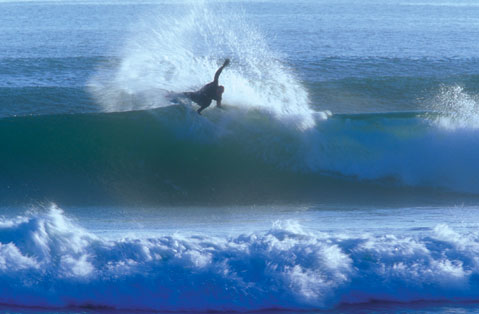
Paddling out online has never been easier, and as a result, it seems, the actual act of surfing has grown incrementally more accessible-that is, surfing online first for information helps you surf in the water later. Monster surf-specific Web sites with tens of thousands of hits a day, such as Surfline.com, have been helping accelerate the surfing learning curve for years, spilling the beans on upcoming swells and current ocean conditions to anyone and everyone no matter what coastline they call home. Now, the information sharing has evolved, taking on a decidedly local bent, with several surf sites made by and for Santa Barbara County wave riders joining the lineup. Whether you consider it progress or a sure sign of the Apocalypse, one thing is for sure: Surfing in the 805 will never be the same.
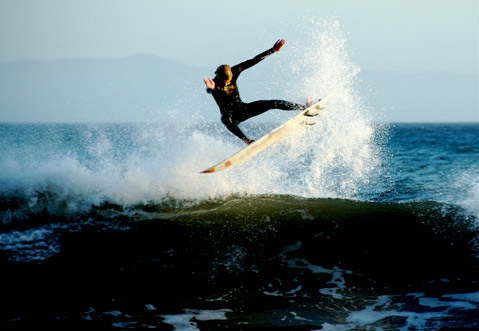
A SaltWater Fabric
“If one person writes about a spot-when it breaks, how to get there, or something like that-that information is online forever. All you have to do is Google it,” said Paul Costales. Better known as Pope, Costales has been the mastermind behind Santa Barbara’s longest running surf Web site, SantaBarbaraSurfing.com, since 2001. The site, which was started by former UCSB PhD student Tim Maddux in 1995 as a no-frills, underground surf report resource, has consciously evolved over the years into more of a local surfing community bulletin board.
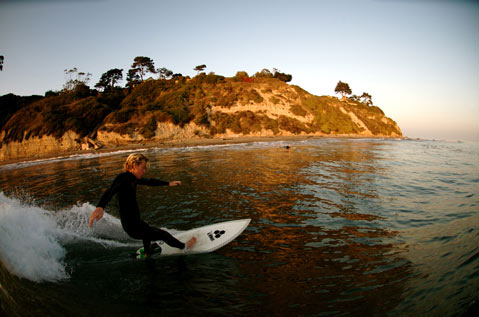
Purposely avoiding the naming of surf spots save for the obvious such as Rincon, Campus Point, and Isla Vista’s Sands Beach, Pope provides recaps after swell events, pictures, and, perhaps most importantly, links to and short stories about the various goings-on in Santa Barbara’s wave-riding tribe. From coastal preservation issues and supposed shark attacks to the fate of the UCSB surf team and upcoming film premieres, SantaBarbaraSurfing.com keeps its visitors-about 100,000 of them a month-in the loop and better connected, but when it comes to the actual pursuit of finding and riding waves, you are still, at least as far as this site goes, on your own. With uncrowded waves about as easy to find around these parts as an uncrowded freeway in Los Angeles, the restraint, in the eyes of many longtime Santa Barbara surfers, is necessary.
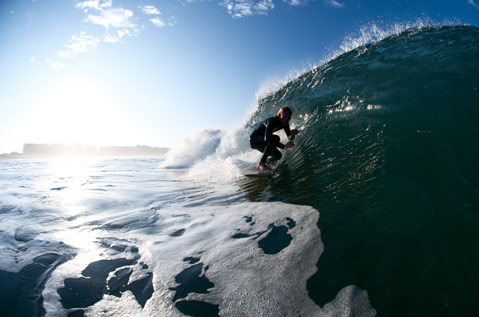
Similarly, Tom Modugno’s GoletaSurfing.com is all about celebrating the fabric of a surfing community while keeping certain sacred bits of information shrouded in mystery. A lifelong Goodland wave hunter, Modugno, who also founded the anti-Bacara Haskells Designs Web site and T-shirt line, calls Goleta, with its agricultural-land-meets-the-sea, working-class vibe, “essential California.” While Santa Barbara gets all the critical acclaim and international reputation, neighboring Goleta is a place where, according to Modugno, “You can still take a hike through a field, get in the water, and catch a few waves by yourself or with just a few friends.” That being said, he quickly points out that the secret and special spots, the very life source of the aforementioned South Coast solitary surfing experience, are getting “fewer and fewer these days” thanks to world-shrinking technologies like the Internet and cell phones.
The soul is still very much intact on GoletaSurfing.com, however, with a visit to its pages reminiscent of a modern-day version of the Bruce Brown surf film experience. Photo essays with cryptic titles like “Little Secrets,” “January Heat,” and “Warm Water Fun,” cast a spotlight on surfers of all ages and abilities as they enjoy the fruits of Goodland surfing while Modugno’s captions serve as an entertaining, often hilarious, and rarely revealing narrative. Add to that his profiles section, in which he uses photos and short captions to document some of the greatest names from the past, present, and future of Goleta surfing like Mike Haskell, Kenny Jorgensen, Bruce Fowler, Bobby Morris, and Demi Boelsterli. You also get an ever-growing historic and permanent mosaic of Goleta’s unique surfing culture the likes of which, without technology, would not be possible.
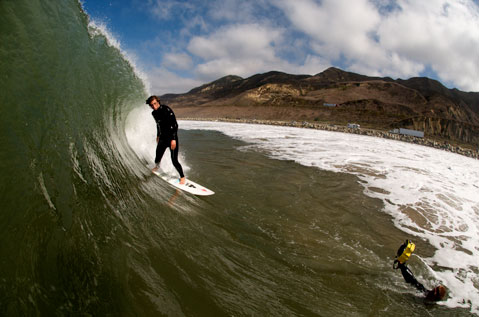
Let the People Speak
“We love surfing. We eat it, we sleep it, we breathe it. As surfers, we have a constant craving for contact with it and Web sites now give us a way of satisfying that craving that we didn’t have before,” said lifelong Santa Barbara surfer Jon Shafer. As a practicing psychotherapist, who also happened to create the largest online BMW community in the world, BeamerFest.com, which enjoys 5 million to 6 million visitors a month, as well as two Santa Barbara-centric surf sites, Shafer is uniquely qualified to assess the intersection of lawless interweb free speak and the long guarded, localism loaded nature of surfing talk.
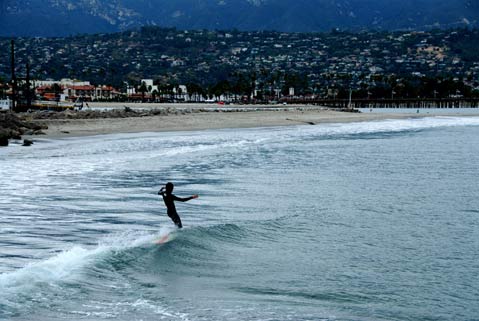
Considered by many to be one of the best right-hand point breaks in the world, Rincon-that majestic, cobblestoned turn in the coast that straddles the Ventura and Santa Barbara County line-is the subject of Shafer’s first Web site, The Rincon Surf Blog (rinconsurfblog.com). Started in February of 2007 when he was laid up with an injury thanks to a vicious wipeout at the ‘Con, the site serves as a personal online ode to the place commonly called “The Queen of the Coast.” Primarily a forum for Shafer to show off his photographs of the wave and the people who ride it-sometimes posted mere hours after a session-the Web site was recently rated the No. 3 surf blog in the world by Blogs.com.
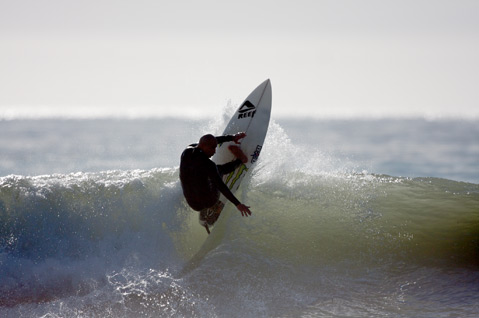
While it enjoys increasing visits-currently the site peaks at about 500 to 600 hits a day-the Web site has not been without its detractors. Though a majority of the feedback has been positive, according to Shafer, he also receives the occasional hateful email and even a few physical threats for doing what he does- a manifestation of localism that he bristles at. “I have lived here my whole life, but I don’t get hung up on localism as much as other people,” said Shafer, before adding with marked tone of irritation, “People have been surfing out there [Rincon] for decades, and you can see it perfectly from the highway. I mean come on, there is just no hiding waves at Rincon.”
It is Shafer’s other contribution to the local surfing Web site landscape that is the most groundbreaking (at least in a Santa Barbara sense), useful, and controversial. Taking a cue from his wildly popular BMW forum, Schafer launched SantaBarbaraSurfer.com last winter and already the user-driven public forum has a healthy and devoted following of nearly 500 members with many more visiting and reading the site’s ongoing dialogues.
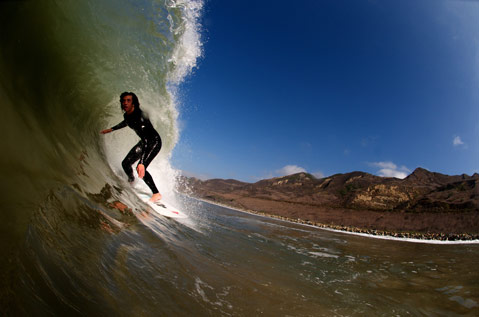
With 11 official forums offering up threads featuring surf reports, board design discussion, user-submitted photo galleries, swell forecasting theories and such, the Web site is the online equivalent of talking story in a parking lot before or after a surf session save for one major difference-literally anyone can listen in. As a result, lesser-experienced surfers have instant access to kernels of knowledge that it took previous generations of boardriders years to learn.
Further, while SantaBarbaraSurfer.com is a gathering place to a broad spectrum of surfers-from middle-aged beginners and experienced old salts to teenage aspiring pros and world-class shapers-the discussions often feature degrees of information sharing that would have been frowned upon in days gone by. This is a fact of life that Shafer acknowledges and says that he is on constant lookout for.
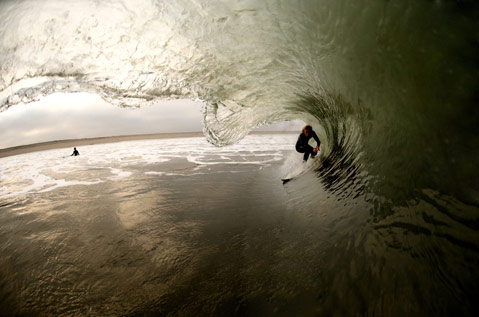
For example, during the aforementioned first swell of the season, a forum user began naming a particularly guarded spot in Goleta, giving updated reports on its status during the swell, answering questions about parking, and even asking other users if it was “safe to surf there.” While the average non-surfing Internet user may not consider this a sin, most seasoned surfers do not take too kindly to such out-of-the-classroom chit chat. As a result, Shafer edited the dialogue a few days after it was posted, replacing the semi-secret spot’s name with initials-something he figures he has to do once every two or three weeks.
“Our idea is not to necessarily broadcast information but rather to build a community,” said Shafer. “But at the same time, nothing is secret anymore and the bottom line is, ultimately, in the past, someone shared that information with you. What we are doing isn’t much different at all.” The fact remains, as one prominent S.B.-born surfer, who admits to using the Internet regularly to inform his surf addiction, put it recently, “I don’t care who is doing it. If you share this stuff online you aren’t making people earn it anymore and that takes a lot of the magic out of surfing.”
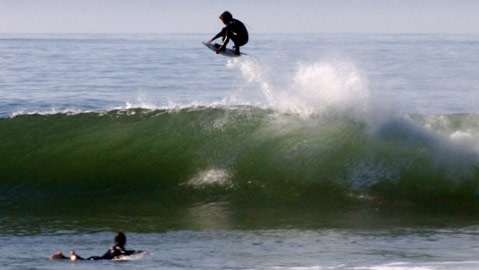
Going Big and Keeping It Real
With an average 270,000 unique visitors a month and as many as 50,000 a day during swell events, WetSand.com is one of the biggest and most prolific surf Web sites in the world. Created nearly 10 years ago by longtime Santa Barbara surfer Chuck Menzel, the site is a beast of enviro-minded news content, surf reports, every ocean forecasting tool imaginable (their new SwellWatch 3d feature is insane and must be checked out by anyone who likes riding waves), original writing, and drool-inducing photographs from around the world, not to mention a surf-oriented online store so popular that it actually prompted Menzel to open up a real-world storefront of the same name in Ventura two years ago.
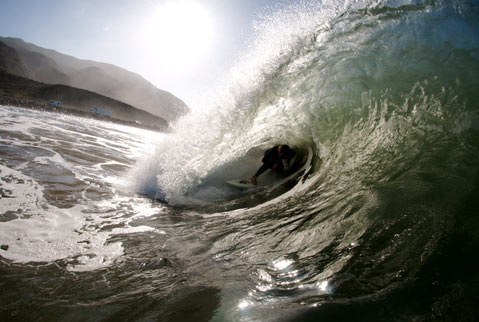
Despite its size and impressive amount of content, Menzel is widely recognized for being able to walk the line between providing useful information and a flagrant spilling of the beans, something he credits to growing up in the notoriously hush-hush surf tribe of Santa Barbara and Goleta. “Sure we are built around surf forecasting,” said Menzel, “but we never say go to this spot because it is good right now or it was good yesterday. We are more about helping you figure it out yourself. That is just the way it was when I was growing up and that is the way I want to keep it.”
Still, acknowledging the trends of the time and the increasing scope of technology such as high-powered Web cams aimed at surf spots, Menzel admits that, in order to stay competitive, WetSand is “doing things now that I would never have done when I first started out.” To him, this shift in values-or tragic loss of longstanding surfing principles depending on your viewpoint-is simply a byproduct of evolution. “I like to try and keep it real and stay committed to the core of surfing, but it is hard,” Menzel said. “How do you really do that on the Internet?” And perhaps the more important question, does the average technology-savvy surfer even want that anymore?
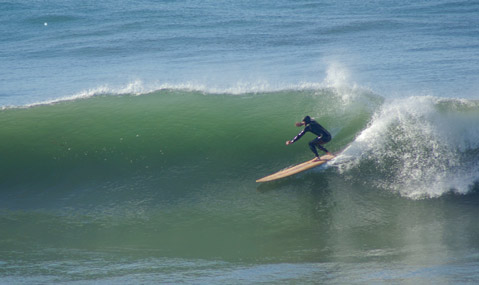
Surfing the Web, Surfing the Beach
An informal survey of wave hunters at places like Rincon and Campus Point by The Independent last weekend showed that more often than not, people do surf the Web before they surf the waves. With high gas prices, busy schedules, and the variable conditions of the sport itself, who can blame them? Ironically, all of those questioned also lamented the downside of surfing’s newest variable. Whether they could articulate it or not, even the youngest surfers interviewed sensed a loss of something long intrinsic to the experience of surfing-be it the absence of surprise, technology usurping knowledge on the totem pole of wave hunting tools, or just a simple reduction in the amount of magic swirling around a life committed to the ocean.
Kevin Long, a student at Santa Barbara City College, scoping the surf in Isla Vista Sunday afternoon, perhaps summed up the dichotomy best. “It’s kind of sad that we depend on them [Web sites] so much. I remember when everyone only knew if it was good by looking at it. Plus, it causes commotion and swells get over-hyped and crowded.” But then, when pressed for his assessment of how the surf looked out at Sands that afternoon, he offered an even greater truth, “Small. I should have checked the Internet.”



